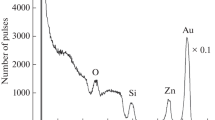Abstract
The aim of the study is to consider the features of the physico–chemical processes in the near-contact region of the semiconductor SiC phase doped with radionuclide by solid-phase diffusion of \({}^{14}\)C atoms, generation of nonequilibrium carriers and the semiconductor phase distinctive characteristic features. The DFT approach in this paper is aimed at obtaining evidence of the vacancy mechanism of diffusion during the formation of the SiC phase in the Si wafer. Radionuclide and silicon atoms counter-diffuse through a growing layer of silicon carbide, forming layers by solid-phase chemical transformation of silicon of \(n\)- or \(p\)-type conductivity into heterostructures of anisotypic or isotypic type of conductivity relative to the SiC phase, with superstecheometric alloying with conservation of the valence and the type of impurity conductivity, forming, depending on the phase, effects energetically manifested as the effect of ‘‘the inner sun,’’ which is the source of electrons and electron–hole pairs at ionization losses. This is due to interactions with the electrons of the shells of neighboring atoms, leading to the formation of electrons and holes in the region of spatial charge and carrying by built-in electric fields. The purpose of the study is due to an increase in the efficiency of separation of electron–hole pairs.



Similar content being viewed by others
REFERENCES
C. Zhou et al., ECS J. Solid State Sci. Technol. 10, 027005 (2021). https://doi.org/10.1149/2162-8777/abe423
V. Bormashov et al., Phys. Status Solidi Appl. Mater. Sci. 212, 2539 (2015). https://doi.org/10.1002/pssa.201532214
S. Theirrattanakul and M. Prelas, Appl. Radiat. Isot. 127, 41 (2017). https://doi.org/10.1016/j.apradiso.2017.05.005
J. Russo et al., Appl. Radiat. Isot. 125, 66 (2017). https://doi.org/10.1002/er.4563
Y. P. Liu et al., Sci. China Technol. Sci. 60, 282 (2017). https://doi.org/10.1016/j.jclepro.2018.02.282
Q. Zhang et al., Proceedings of the IEEE International Conference on Micro Electro Mechanical Systems 1177 (2016). https://doi.org/10.1109/MEMSYS.2016.7421830
A. V. Gurskaya, M. V. Dolgopolov, and V. I. Che- purnov, Physics of Particles and Nuclei 48 (6), 941 (2017). https://doi.org/10.1134/S106377961706020X
T. Shimaoka et al., Appl. Phys. Lett. 117, 103902 (2020). https://doi.org/10.1063/5.0020135
X. Li et al., Nucl. Sci. Tech. 31, 18 (2020). https://doi.org/10.1007/s41365-020-0723-y
O. L. Surnin and V. I. Chepurnov, RF Patent 2733616 C2, 05.10.2020.
J. D. Hong and R. F. Davis, Journal of the American Ceramic Society 63, 546 (1980). https://doi.org/10.1111/j.1151-2916.1980.tb10762.x
M. H. Hon and R. F. Mater, Journal of Materials Science 14, 2411 (1979). https://doi.org/10.1007/BF00737031.
M. Dolgopolov et al., EPJ Web of conferences 222, 02012 (2019). https://doi.org/10.1051/epjconf/201922202012
P. Hohenberg and W. Kohn, Phys. Rev. B 136, 864 (1964). https://doi.org/10.1103/PhysRev.136.B864
W. Kohn and L. Sham, Phys. Rev. 140, A1133 (1965). https://doi.org/10.1103/PhysRev.140.A1133
M. V. Dolgopolov et al., Journal of Physics: Conference Series 1686 (1), 012040 (2020). https://doi.org/10.1088/1742-6596/1686/1/012040
S. Y. Davydov, Phys. Solid State 46, 238 (2004). https://doi.org/10.1134/1.1649417
N. Liu, W. Wang, and L. Guo, Modern Physics Letters B 31 (12), 1750116 (2017). https://doi.org/10.1142/S0217984917501160
GEANT4 Documentation, https://geant4.web.cern.ch.
M. V. Dolgopolov et al., Computational Nano- technology 8 (3), 59 (2021). https://doi.org/10.33693/2313-223X-2021-8-3-59-68
V. A. Pokoeva and K. P. Sivakova, Physics of Wave Processes and Radio Systems 10 (2), 110 (2007).
V. I. Chepurnov, Vestnik Samarskogo Gosu- darstvennogo Universiteta. Estestvenno-Nauchnaya Seriya 7 (118), 145 (2014). https://doi.org/10.18287/2541-7525-2014-20-7-145-162
S. A. Radzhapov et al., Comp. Nanotechnol., No. 3, 65 (2018).
ACKNOWLEDGMENTS
M.V. Dolgopolov expresses gratitude to the organizers of the LXXII International Conference ‘‘NUCLEUS-2022’’ for the opportunity to speak and discuss the results of the study.
Funding
Part of the research of A.V. Gurskaya was supported by the scholarship of the President of Russia 2022.
Author information
Authors and Affiliations
Corresponding authors
Ethics declarations
The authors declare that they have no conflicts of interest.
About this article
Cite this article
Gurskaya, A.V., Dolgopolov, M.V., Chepurnov, V.I. et al. Contacts for SiC Nano-Microwatt Energy Converters. Moscow Univ. Phys. 78, 14–20 (2023). https://doi.org/10.3103/S0027134923010149
Received:
Revised:
Accepted:
Published:
Issue Date:
DOI: https://doi.org/10.3103/S0027134923010149



